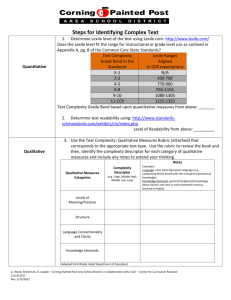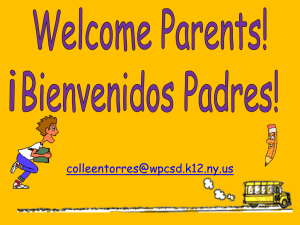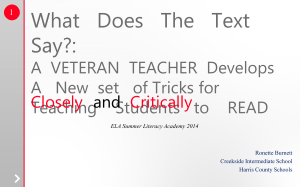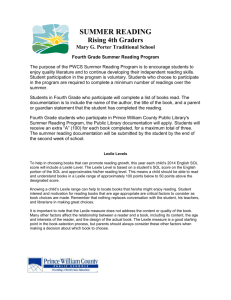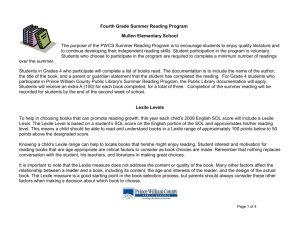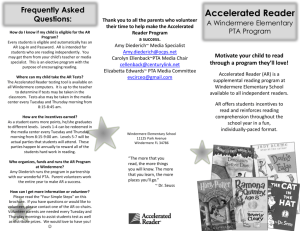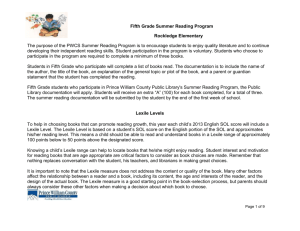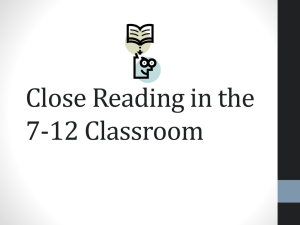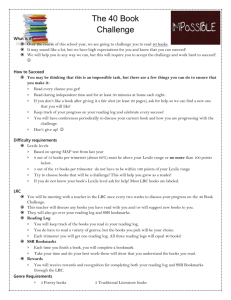Reading Standards & Text Complexity
advertisement
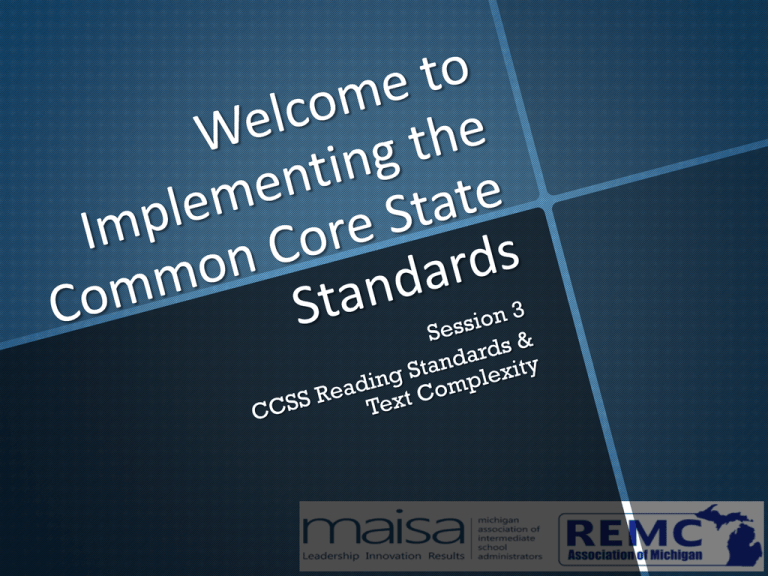
Outcomes for This Session Receive background knowledge about the Common Core Reading Standards and Text Complexity Who is Responsible? Elementary teachers K-5 Science, Social Studies, & History teachers 6-12 Secondary ELA teachers 6-12 Common Core Standards REVIEW THE STANDARDS FOR YOUR GRADE LEVEL (5 minutes) • What do you see? HIGHLIGHT GREEN • What do you notice? HIGHLIGHT YELLOW PARTNER WITH MEMBERS FROM 2 ADJACENT GRADE LEVELS (5 minutes) • What do you see between grade levels? HIGHLIGHT PINK • What do you notice about student readiness? HIGHLIGHT ORANGE 4 Reading Standard Strands (K-12) Key Ideas and Details Strand (3 Standards) Integration of Knowledge and Ideas Strand (3 Standards) ELA for Literature, Informational- ELA Science, SS & History Craft and Structure Strand (3 Standards) Range and Level of Text Complexity Strand (1 Standard) 10 College and Career Readiness Anchor Standards for Reading (K-12) Range and Level of Text Complexity See Standards Document K-5 Page 11 6-8 Page 36 10. Read and comprehend complex literary and informational texts independently and proficiently 9-12 Page 38 Content Pages 6162 Increasing text complexity is Required for College and Career Readiness Look at Text Exemplars GO TO: Appendix B--Table of Contents pages 4-13 1--Find your grade level range in the Elementary (K-5) Middle (6-8) High School (9-12) 2--Look at: Excerpts Performance Tasks Shifts in ELA/ Literacy Shift 1 Building Knowledge Through Content-Rich Non-Fiction Building knowledge through content rich non-fiction plays an essential role in literacy and in the Standards. Shift 2 Reading, Writing, and Speaking Grounded in Evidence from Text, Both Literary and Informational The Standards place a premium on students writing to sources, i.e., using evidence from texts to present careful analyses, well-defended claims, and clear information. Shift 3 Regular Practice with Complex Text and its Academic Language Rather than focusing solely on the skills of reading and writing, the Standards highlight the growing complexity of the texts students must read to be ready for the demands of college and careers. Refer to Shifts Handout Why Text Complexity ? Performance on complex texts is the clearest differentiator in reading between students who are likely to be ready for college and those who are not. This is true for both genders, all racial/ethnic groups, and all annual family income levels. ACT Reading Between the Lines Text complexity is defined by 3 factors: 1. Reader and Task – background knowledge of reader, motivation, interests, and complexity generated by tasks assigned 2. Quantitative measures – readability and other scores of text complexity 3. Qualitative measures – levels of meaning, structure, language conventionality and clarity, and knowledge demands Reader and Task Quantitative Dimensions • Word length/frequency • Sentence length • Text Cohesion Evaluating Text Complexity Lexiles are quantitative measures Lexile measures are based on two well- established predictors of how difficult a text is to comprehend: word length, frequency, and sentence length. More Information: http://www.lexile.com/ http://www.corestandards.org/the-standards Figure 3: Text Complexity Grade Bands and Associated Lexile Ranges (in Lexiles) Text Complexity Grade Band in the Standards Old Lexile Ranges Lexile Ranges Aligned to CCR expectations K–1 N/A N/A 2–3 450–725 450–790 4–5 645–845 770–980 6–8 860–1010 955–1155 9–10 960–1115 1080–1305 11–CCR 1070–1220 1215–1355 Life After Graduation “Student Readiness for Postsecondary Options” Gary Williamson, Ph.D. (2004) Median Text Measures: • 11th/12th grade (LA/SS textbooks): • Military (training/field manuals): • Citizenship (newspapers, voting, jury): • Workplace (Daggett study materials): • Postsecondary - first two yrs (textbooks): – GED Test Materials: – SAT/ACT Test Materials: 1090L 1180L 1230L 1260L 1355L 1060L 1180L College and Career Readiness Skills Reading Demand of Newspapers Match the Newspaper to the appropriate lexile. Note one lexile will be used more than once. • • • • • • 1200L 1310L 1320L 1350L 1380L 1440L • • • • • • • USA Today Wall Street Journal New York Times Washington Post Chicago Tribune Reuters Associated Press College and Career Readiness Skills Reading Demand of Newspapers • • • • • • • USA Today (1200L) Associated Press (1310L) Chicago Tribune (1310L) Wall Street Journal (1320L) Washington Post (1350L) NY Times (1380L) Reuters (1440L) Limitations of Lexile Measures What Lexile text measures do not address Text Characteristics Reader Characteristics Age-appropriateness of Interest and motivation Background knowledge Reading context and the content Text support (e.g., pictures, pull-outs) Text quality (i.e., Is it a purpose good book?) Lexile text measures only measure text readability. Input from readers, parents, teachers and librarians is necessary. Reader & Task Considerations • Cognitive Capabilities • Motivation • Knowledge •Experiences Evaluating Text Complexity Qualitative Dimensions • Levels of Meaning/ Purpose •Text Structure •Language •Knowledge Demands Evaluating Text Complexity QUALITATIVE DIMENSIONS of Text Complexity 1—LEVELS OF PURPOSE: Is the purpose explicitly stated? Or is it obscure or hidden? 2—STRUCTURE: Organization: Simple, well-marked conventions? Or unconventional structure? Sequence: easy to follow? Or flashbacks? Framed stories? Graphics: Add on? Or necessary to understand the text? 3—LANGUAGE CONVENTIONALITY & CLARITY: Language: Contemporary & literal? Or ambiguous, misleading, archaic, unfamiliar? 4—KNOWLEDGE DEMANDS: Does not go much beyond depth of reader’s knowledge? OR makes assumptions that reader has a vast knowledge of the topic? Appendix A—pp. 5 & 6 Martin Luther King’s Letter from Birmingham Jail What makes this complex? Martin Luther King’s Letter from Birmingham Jail From Dr. Anita Archer, Dynamic Vocabulary Instruction REFLECTION More information and updates can be found for Common Core State Standards can be found on: MDE website: www.michigan.gov/mde Common Core State Standards: www.corestandards.org Smarter Balanced Consortia: www.k12.wa.us/smarter/ 32
